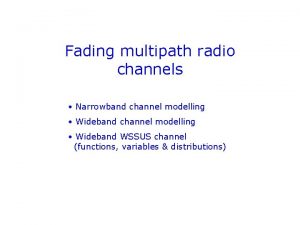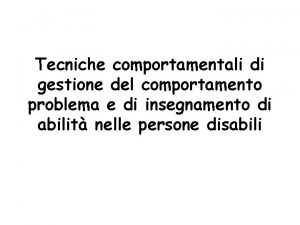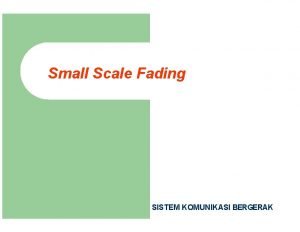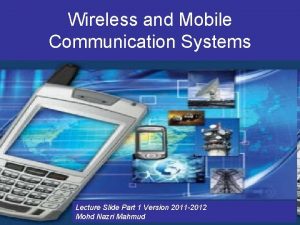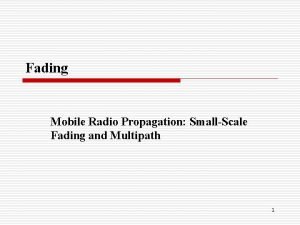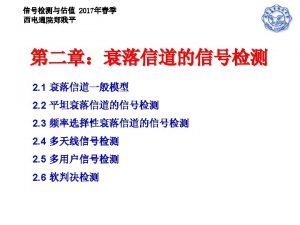Diversity Reception To reduce fading effects diversity reception








- Slides: 8

Diversity Reception • To reduce fading effects, diversity reception techniques are used. Diversity means the provision of two or more uncorrelated (independent) fading paths from transmitter to receiver • These uncorrelated signals are combined in a special way, exploiting the fact that it is unlikely that all the paths are poor at the same time. The probability of outage is thus reduced. • Uncorrelated paths are created using polarization, space, frequency, and time diversity

Space Diversity Height Power • A method of transmission or reception, or both, in which the effects of fading are minimized by the simultaneous use of two or more physically separated antennas • Antennas must be spatially distant so that no correlation exists between fading phases (one or more wavelengths).

Polarization Diversity Time Power (Horizontal) Power (Vertical) • Diversity transmission and reception wherein the same information signal is transmitted and received simultaneously on orthogonally polarized waves

Frequency Diversity • Transmission and reception in which the same information signal is transmitted and received simultaneously on two or more carrier frequencies. • The frequency difference must be high enough so there no correlation exists between their fading phases

Diversity Combining - Switching Comparator RF switch Fixed Threshold RSSI Sync IF FC + FIF To Detector Average Comparator RF switch RSSI Sync IF To Detector FC + FIF • The current branch remains selected until a metric fails a certain threshold, the Received Signal Strength Indicator (RSSI). The next branch is then blindly selected. • An adaptive threshold removes unnecessary switching. When the signal fades relative to the mean, switching occurs • Cheap and simple.

Diversity Combining - Selection Rx Rx RSSI Selection Logic Rx RSSI Detector • Uses M receiversbranches, compares signals and selects the best one. • Slight performance advantage over switch diversity • The system is expensive • Using RSSI as indication is unduly affected by interference

Diversity Combining – EGC 1 1 Co-phasing & Summing 1 Detector • Equal Gain Combining • All branches are merely co-phased and summed

Diversity Combining – MRC a 2 a. M Co-phasing & Summing a 1 Detector • Maximal Ratio Combining • Each branch is weighted before summationin proportion to its own signal-to-noise ratio • Slightly better performance than EGC but more complex

